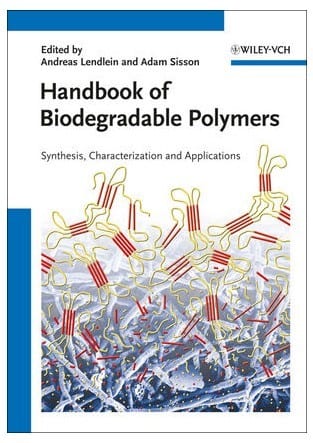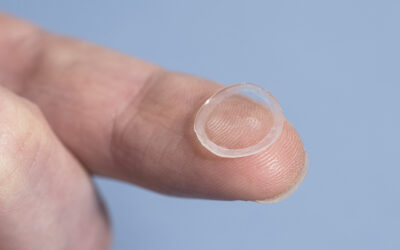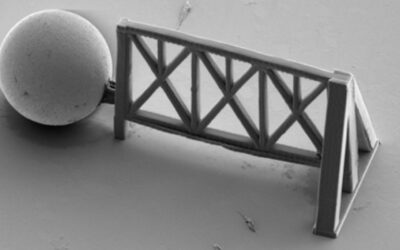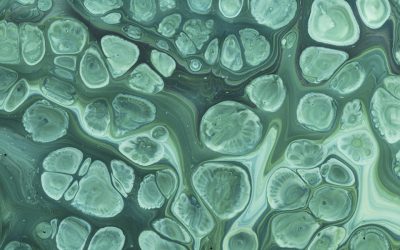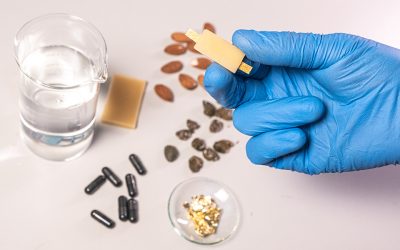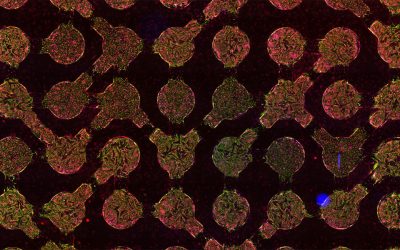 Handbook of Biodegradable Polymers: Isolation, Synthesis, Characterization and Applications
Handbook of Biodegradable Polymers: Isolation, Synthesis, Characterization and Applications
Andreas Lendlein (Editor), Adam Sisson (Editor)
ISBN: 978-3-527-32441-5
Hardcover / E-book
426 pages
€150.00 / €132.00
Click here for more information
Reviewed by Seema Agarwal, Universität Bayreuth, Germany
Biodegradable polymers are highly relevant not only as environmentally friendly materials but also show great potential and advantages in many other fields like agriculture, medicine, pharmaceuticals, biomedicine, etc. Many different biodegradable polymeric architectures, forms (fibers, films, foams, particles, etc.) and application areas have been developed in the last few years. The concepts of tuning degradability rates, mechanical and thermal properties and biocompatibility by copolymerization and blending are well-established to make a biodegradable material suitable for a specific application. The Handbook of Biodegradable Polymers: Synthesis, Characterization and Applications, edited by Andreas Lendlein and Adam Sisson, covers different aspects of biodegradable polymers, such as description and properties of technically relevant natural and synthetic polymers, macromolecular architectures, important application areas like drug delivery and tissue engineering, analysis and modeling techniques in 16 chapters written by different authors.
Aliphatic and aliphatic-aromatic polyesters are commercially available and academically highly studied examples of biodegradable polymers. The first chapter with the title polyesters provides an overview of mainly aliphatic ones describing their methods of synthesis, macromolecular architectures, physical properties and biomedical applications supported by a good number of literature references. Although the chapter does not give in-depth information about the biodegradation phenomenon and classification of polyesters, important aspects of aliphatic polyesters related to biomedical applications are given by picking up the right examples.
Aliphatic polyesters of microbial origin (polyhydroxyalkanoates (PHAs)) are described in chapter 2 by Araḡao et al. This very informative chapter presents historical background, structure, biosynthesis, extraction procedures and degradability of PHAs. The chapter ends with the authors’ view regarding future directions related to research concerning PHAs. It is a well-written chapter and could be useful to both experts and beginners in the field of biodegradable polymers.
A complete chapter 3 is rightly devoted to a special type of biodegradable polymer: polyanhydrides, which show a rare surface erosion phenomenon that is being used clinically in products like Glidel and Septacin for drug delivery applications. This well-written, easy to understand chapter giving details about all important aspects of polyanhydrides including classification and syntheses with examples, biomedical applications, thermal and mechanical properties and both in vitro and in vivo degradation studies. Physicochemical properties of some important polyanhydrides are listed in a table for easy reference.
Another important class of biodegradable polymers is poly(ortho esters) (POEs). Although many different generations of POEs have been developed, they could not be commercialized due to very fast hydrolysis, difficult and non-reproducible synthesis of the starting monomers and polymers, unsatisfactory mechanical properties, etc. They are the highlight of chapter 4 written by Jorge Heller describing chemistry with reaction procedures for the synthesis with more emphasis on the last promising generation made by reaction of diketene acetal with a mixture of diols and latent acid diols.
Chapter 5 presents a short review regarding poly(ester amides), poly(ester urethane)s and poly(ester urea)s based on naturally occurring α-amino acids. Various examples of these three classes of polymers are highlighted with their synthetic methods and properties. Although for easy understanding of the chemistry lots of reaction schemes are given, redrawing is necessary in the new edition of the book with uniform font size and bond lengths. A table compiling important polymers with structure, properties and literature references would make this chapter more attractive.
Biodegradable polyurethanes, an important class of biomaterials, are being researched increasingly and tried for different biomedical applications. The first part of chapter 6 deals with the synthesis and properties of biodegradable petro- and biobased polyurethanes. Biodegradation mechanism and biomedical applications of biodegradable polyurethanes are also discussed with relevant literature references. A compilation of physicochemical properties of the most studied and used biodegradable polyurethanes would have made this part of the chapter complete. Poly(ester amide)s are introduced in short in the second part of the chapter without providing too many details about degradation behavior, application areas and physical properties, though, a good collection of literature is given for further reference.
Chapter 7 is a very crisp compilation of many different polysaccharides discussing origin, structure and properties in sufficient detail for both beginners and experts in this field with 200 literature references.
Shape memory polymers remember their shape and come back to their predefined shape with external stimuli like temperature or light. Combination of biodegradability and the shape memory property is highly desirable for many biomedical applications like minimal invasive surgery, sutures, etc. The basics of shape memory polymers, classification and applications are described in short in chapter 8 in an easy to understand way. Biodegradable elastic hydrogels (chapter 9) are interesting biomaterials for use in tissue engineering and other biomedical applications. A short description of elastic hydrogels with many examples and properties are described.
Dendrimers are monodisperse, three-dimensional globular structures with symmetrical branches emerging from a core. Inter-cavity, low polydispersity and large number of end-functional groups make them interesting substitutes of linear biodegradable polymers for applications like drug release, gene transfection, catalysis, coatings, etc. Chapter 10 is an informative review regarding this important macromolecular architecture with emphasis on examples of degradable dendrimers, synthesis and biocompatibility.
Biodegradation is a complex process affected by the type of the materials, microorganisms and the environment in which the material is being degraded. Terms like enzymatic degradation, hydrolytic degradation, erosion, compostability, etc. are used interchangeably with biodegradability in the literature. A clear definition of these and more related terms (maybe referring to the IUPAC recommendations) would have been helpful in the form of a small chapter in the handbook. The authors of chapter 11 have depicted the complexity of the biodegradation process in relation to the requirement of having a right method of analysis depending on the type of material to be degraded and the environmental conditions. Plenty of references are given at different places in the text about methods standardized by standardization organizations like ASTM, ISO, etc. for biodegradability tests (mostly in vitro test methods).
The important application areas of biodegradable polymers in tissue engineering and drug delivery applications are dealt with in three different chapters. Modeling and simulation of microbial degradation is described in chapter 12 with poly(ethylene glycol), poly(vinyl alcohol) and polylactide as representative examples. Oxobiodegradable polymers are the topic of the last chapter. The title does not reflect the contents of the chapter as it is too specific describing only polyolefins like polyethylene without discussing other classical examples like poly(vinyl alcohol) and natural rubber.
In short, the handbook is a very good reference for getting information about different types of biodegradable polymers with important examples, synthetic procedures, and application areas, specifically for medicine and biomedical applications. Less focus is on environmentally friendly aspects of biodegradable polymers.

